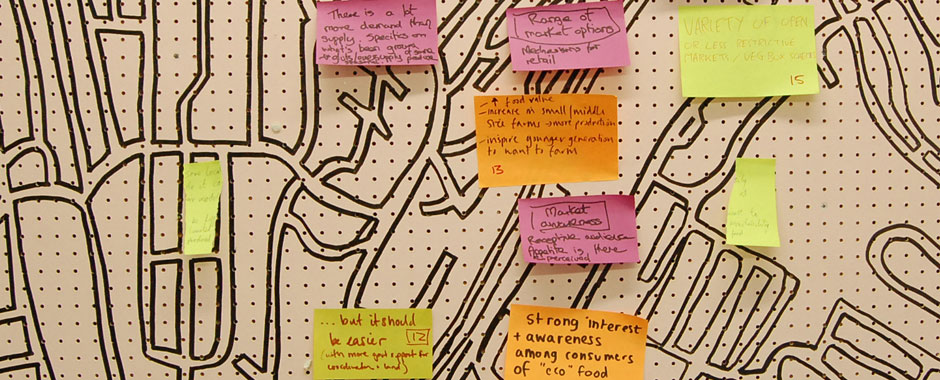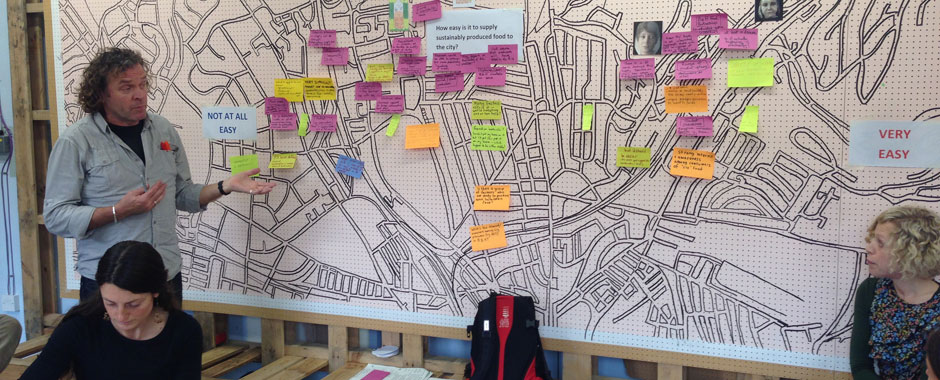Background
Evaluation H derives from the H-form/ ‘Rugby Post form’ Evaluation method developed by Andy Inglis in 1997 to assist local people in Somalia in monitoring and evaluation (Guy and Inglis 1999, see references below).
Beyond a standard ‘continuum’ or ‘line’ method that allows participants to position themselves (or their perspectives) on a line of possibilities, Evaluation H has an additional dimension. It encourages participants to directly and specifically identify the positive or negative factors that influence their position on the line. They can be clustered, and, through a facilitated process, used as a focus for discussing what needs to happen to build upon and strengthen positive factors, or to overcome or address negative factors, in order to support an overall objective.
A variant of the Evaluation H process has been used by STEPS Centre researchers investigating ‘Transformative Pathways to Sustainable Food Systems in Brighton & Hove’ in December 2016, which drew together producers, consumers, retailers/ restauranteurs and civil society organisations working in the area. The workshop was facilitated by Ben Messer of Food Matters. It was part of a multi-national transdisciplinary research project, the PATHWAYS Network, funded by the International Social Science Council.
What’s involved?
The facilitator of the exercise poses a question to the group which is related to the issue being explored, with the question written at the top of a wall, table, or large sheet of paper (the work surface).
A horizontal line is drawn across the centre of the work surface, providing a continuum for opinions, for example, good to bad, easy to difficult, important to not important. Participants are each given sticky notes and pens, and asked to consider their response to the question posed by the facilitator and where on the continuum reflects/represents their response. Participants are also asked to write the factors (positive and negative) which influence why their response falls at the position on the continuum they have identified.

Once all participants have added their sticky notes to the work surface, each of the responses is discussed with every participant having the opportunity to explain their perspective. The factors identified can be positive or negative, and are usually attached to vertical lines at either end of the continuum (hence the ‘H’ or rugby post name). Ideally the factors are then clustered to identify any common themes that arise and then each distinct cluster can be analysed, i.e. what needs to happen to overcome or address this negative factor, or to build upon and strengthen this positive factor.
Broadening out and opening up
The Evaluation H method is useful for identifying different perspectives along a continuum. As long as a broad range of perspectives are present and feel free to contribute, this is effective at broadening out discussions around an issue. Ideally, the method brings plural perspectives on the issue to an equal status but can also highlight ‘outliers’ or more marginal views. The dialogue which explores participant’s responses then opens up in an attempt to address the plurality of framings.
This method can be effective if participants represent different sectors, backgrounds, or types of involvement in the issue being explored, particularly if these different stakeholders do not interact often. The dialogue created through discussion of each participant’s response can identify multiple diverse ideas, opportunities, strategies, or recommendations.

In our workshop in Brighton and Hove, policy-makers, retailers, farmers and producers, researchers, and caterers participated in the exercise (see this blogpost for a reflection on the discussion).
Participants were asked: How easy is it to supply sustainably produced food to the city? The Evaluation H produced responses right across the continuum from ‘easy’ to ‘not at all easy’, including one respondent who provided multiple responses at different points along the continuum due to the complexity of the issue.
Fits and limits
The Evaluation H method will engage participants, including a potential range of stakeholders as participants. Discussion of each participant’s responses allows each diverse perspective to be explored, bringing different framings of issues to the surface. Dialogue emerging from discussion can address dynamics between plural perspectives, including tensions, commonalities, gaps, or opportunities.
A strength of the Evaluation H method is that can engage a range of stakeholders, sectors, and backgrounds on an even plane, where each participant is held as equal and their responses given equal importance (although this is dependent on appropriate facilitation). This allows each participant to give their perspective in their response to the question without feeling judged or marginalised by other participants.
Conversely, a potential weakness of the method is that (especially if the exercise is poorly facilitated) participants may not feel comfortable, willing, or able to give their perspective or reflect on their response with others.
References and links
This vignette has been referenced on the td-net repository of Methods and tools for co-producing knowledge.
Guy, S., and Inglis, A.S. (1999) Tips for trainers: Introducing the ‘H-form’ – a method for monitoring and evaluation, In: Gujit, I., and Braden, S. (Eds) (1999) Learning from Analysis, Participatory Learning and Action Notes, Issue 34, International Institute for Environment and Development, London, pp84–87
